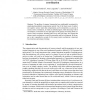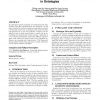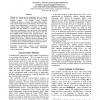1756 search results - page 190 / 352 » On Cognitive Interference Networks |
ICANN
2003
Springer
15 years 3 months ago
2003
Springer
The problem of category learning has been traditionally investigated by employing disembodied categorization models. One of the basic tenets of embodied cognitive science states th...
73
Voted
ATAL
2006
Springer
15 years 2 months ago
2006
Springer
In multiagent systems ontologies are essential because they facilitate tasks like communications and reasoning. In this paper, inspired by studies in cognitive psychology, we pres...
APCCM
2009
14 years 12 months ago
2009
Database Semantics (DBS) is a computational model of how communicating with natural language works. at a level of abstraction which may be applied to natural and artificial agents...
TROB
2008
14 years 10 months ago
2008
Affordances encode relationships between actions, objects and effects. They play an important role on basic cognitive capabilities such as prediction and planning. We address the p...
COGSR
2011
14 years 5 months ago
2011
Methods for cleaning up (or recognizing) states of a neural network are crucial for the functioning of many neural cognitive models. For example, Vector Symbolic Architectures pro...



